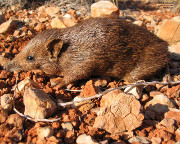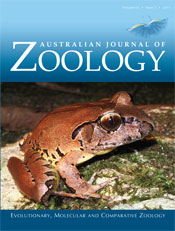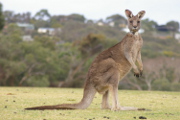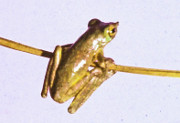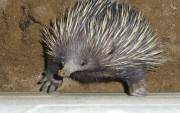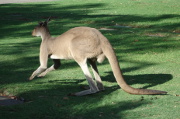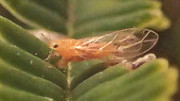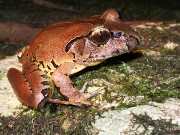Australian Journal of Zoology
Volume 63
Number 3 2015
Bandicoots and bilbies present an interesting assortment of skeletal attributes that set them apart from other marsupials. Here we provide a description of the hind limb muscles of the southern brown bandicoot (Isoodon obesulus) and greater bilby (Macrotis lagotis), and consider how morphology reflects behaviour among peramelemorphians.
Photo by Wes Bancroft.
We examined the helminth community and infection patterns of eastern grey kangaroos (Macropus giganteus) at three sites in Victoria. Combined field experiments and observations allowed us to construct a generalised life cycle of the community and provide new information on seasonal patterns of infection in this host species.
Photo by Graeme Coulson.
This paper describes the anatomy of the elongate proboscis of the male in two species of New Guinean tree frogs and speculates on its function.
Photo by James Menzies.
Provision of burrow boxes to captive short-beaked echidnas coincided with a substantial increase in reproduction with 13 young being born to four females in the years 2011–14. Reproductive behaviours were documented as well as evidence for polyoestry and production of multiple young from one female from one breeding event.
Photo by Andrea Wallage.
Pentapedal locomotion is the use of the tail as a fifth limb by kangaroos. Though often considered characteristic of Macropodinae, we report that pentapedal locomotion is not universal in this group. Our findings also lend support to the hypothesis that pentapedal locomotion is associated with relative lengthening of the tibia, which itself is associated with both increased body size and habitat use.
Photo by Nick Milne.
We describe 14 polymorphic microsatellite loci for the critically endangered plant-louse, Trioza barrettae (Hemiptera : Triozidae), from southwest Australia. These markers will be used to investigate patterns of genetic diversity across the landscape and whether there is genetic structure congruency between populations of T. barrettae and its host plant.
Photo by Melinda Moir.
To assess the viability of soft-sediment tidepools as nurseries, we assessed the abundance of benthic meiofauna food sources found in the sediment. Nematodes and copepods were the most abundant prey and the pools supported persistent meiofaunal communities that are likely to provide prey resources for juvenile and small fish.
Fleay’s barred frog (Mixophyes fleayi) is an endangered species in need of periodic monitoring to determine population trends. We conducted capture–mark–recapture at Brindle Creek in Border Ranges National Park, New South Wales. Population modelling suggests the local population has remained relatively stable for up to 10 years.
Photo by Ross Goldingay.
The present study assessed the annual reproductive cycle of brook trout under the ambient photoperiod in Tasmania. It was found that fish recruited for maturation following the summer solstice in December. This finding indicates that maturation suppression by photoperiod manipulation should be instigated prior to initiation of oocyte recruitment that commenced during December.
Photo by Kamil Latif.
